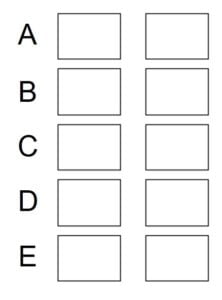Blood tray
This activity was created as part of a Gratnells What’s In My Tray CPD workshop for secondary science teachers and technicians to support practical work and delivery of the curriculum. It can be carried out as a stand-alone activity for students or combined with other activities from the session to form a STEM carousel.

You will need (per team of 4):
- 2 x Red shallow Gratnells F1 trays with lids
- 1 x 6-section tray insert
- Red water beads sufficient to half fill one shallow tray
- 1 litre water (for plasma)
- Yellow food colouring
- 10 x Small yellow Lego bricks
- 10 x White marshmallows
- 6 x White ping pong balls with antibody symbols (Y) drawn on using a permanent pen
- 4 x Big plastic tweezers
- 4 x Plastic spoons
- Absorbent cloths or tea towels for any spills
- Laminated name and function cards for the blood components
- A pre-printed answer sheet or a blank piece of paper and a pen/pencil
This activity also works for individuals or smaller teams, just increase the amount of time allocated to complete it. Once prepared, this activity can be repeated multiple times, reusing the same equipment for each team.
Preparation:
- Print and laminate one set of the blood component name and function cards.
- Print one copy of the answer sheet per participating team.
- Draw the antibody symbols (Y) on the white ping pong balls using a permanent pen.
- Make up the water beads at least three hours ahead of the activity following the manufacturers instructions.
- Combine 1 litre of water with a few drops of yellow food colouring and keep to one side.
- Just before the activity, add the fully expanded water beads to an empty shallow tray and add sufficient yellow water to cover them.
- Submerge the rest of the blood components in the water bead and yellow water mixture. Put the lid on the tray.
- Place the laminated cards, spoons and tweezers into a single section of the tray insert, place the insert into the empty shallow tray and put the lid on.
What to do:
- Approach the trays and lift the lids.
- Using the tweezers and spoons, search for the various representative components of blood and separate them into the tray containing the grey six-section insert, give each component its own section. Tip: you do not have to separate and transfer all the red water beads, a sample is fine.
- Match each component to its name and function cards by placing the cards into the insert section with their matching blood component.
- Once you are confident you have everything matched up, take a picture to evidence your work.
- Write the letter found on each card in the following order on the answer grid provided: item, name, function. Start with the item letter provided. e.g. B, H, G.
Blood Tray – example answer grid

Tidy up time:
- Put all components back into the blood tray.
- Put the tweezers, spoons, name and function cards back into their original section of the 6-section insert.
When all participants/teams have completed the activity, swap answers with the next team and mark the answers. The activity leader will put the list of correct answers up on the screen/board and call them out.
Answers:
A, J, G Red water beads – Red Blood Cells
B, F, L Yellow liquid – Plasma
C, H, N Yellow Lego – Platelets
D, M, K White marshmallows – Phagocytes
E, I, O Ping Pong Balls – Lymphocytes
What is happening?
The average adult has about 5 litres of blood circulating around their body at any one time, it moves at an average speed of 3-4 miles per hour and makes up between 7 to 8% of total body weight. Blood’s main function is to transport things around the body via the circulatory system, this includes gasses, such as oxygen and carbon dioxide, nutrients from the digestive system, waste products, heat, water, salts and hormones. Blood also transports the specialist cells and components required for fighting infections, healing wounds and clotting. The specialist cells within the blood carry out many of these important functions. Through this activity you have explored some of the components of blood, their names and basic functions.
Other things to try…
- Research the different components of blood and create more detailed function cards to add to this activity.
- Discuss why each representative object has been selected for each blood component.
- What other objects could you add to the tray represent the other things transported by the blood? e.g. nutrients, waste products, heat, salts and hormones. Research each of these to help you decide on appropriate representative objects. Create name and function/description cards for each of these items.
- Re-set the activity with the additional components and cards and challenge others to complete the more advanced version.
- Can you create a blood tray using correct, representative, quantities of the different components? e.g. blood composition is 55% plasma and 45% cells. The plasma is 92% water and 8% proteins including hormones and enzymes, ions, sugars, amino acids, and nitrogenous waste. The cells are 99% red blood cells and 1% platelets and white blood cells. Tip: You could do this by weight.
- For younger or lower ability students, simplify the activity by not differentiating the white blood cells in to the two types and simplify the function cards accordingly.
- For higher ability students, they could explore the different types of white blood cells (neutrophils, eosinophils, basophils, lymphocytes, monocytes), where they are produced and their role in immunity.
- Share your blood tray photographs on social media using #WhatsInMyTray.
Health & Safety
As with all Gratnells Learning Rooms What’s In My Tray activities, you should carry out your own risk assessment prior to undertaking any of the activities or demonstrations.


